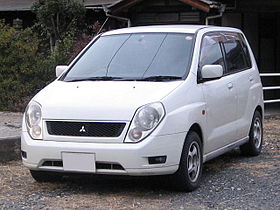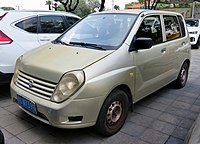This article needs additional citations for verification .(December 2018) |
| Mitsubishi Mirage Dingo | |
|---|---|
 Pre-facelift Mitsubishi Mirage Dingo | |
| Overview | |
| Manufacturer | Mitsubishi Motors |
| Also called | Hafei Saima (China) |
| Production | 1998–2003 2001–2014 (China) |
| Assembly | Japan China: Harbin (Hafei) |
| Body and chassis | |
| Class | Mini MPV |
| Body style | 5-door hatchback |
| Powertrain | |
| Engine | 4G13 1.3 L I4 4G15 1.5 L GDI I4 4G93 1.8 L GDI I4 (2000–03) |
| Transmission | INVECS-II 4-speed automatic (1998–2000) 4-speed automatic (2000–03) INVECS-III CVT (2000–03) |
| Dimensions | |
| Wheelbase | 2,440 mm (96.1 in) |
| Length | 3,885–3,920 mm (153.0–154.3 in) |
| Width | 1,695 mm (66.7 in) |
| Height | 1,620–1,635 mm (63.8–64.4 in) |
| Curb weight | 1,170–1,280 kg (2,579.4–2,821.9 lb) |
| Chronology | |
| Successor | Mitsubishi Colt |
The Mitsubishi Mirage Dingo is a mini MPV built by Mitsubishi Motors from 1998 to 2003, using a shortened version of the Mirage platform.







